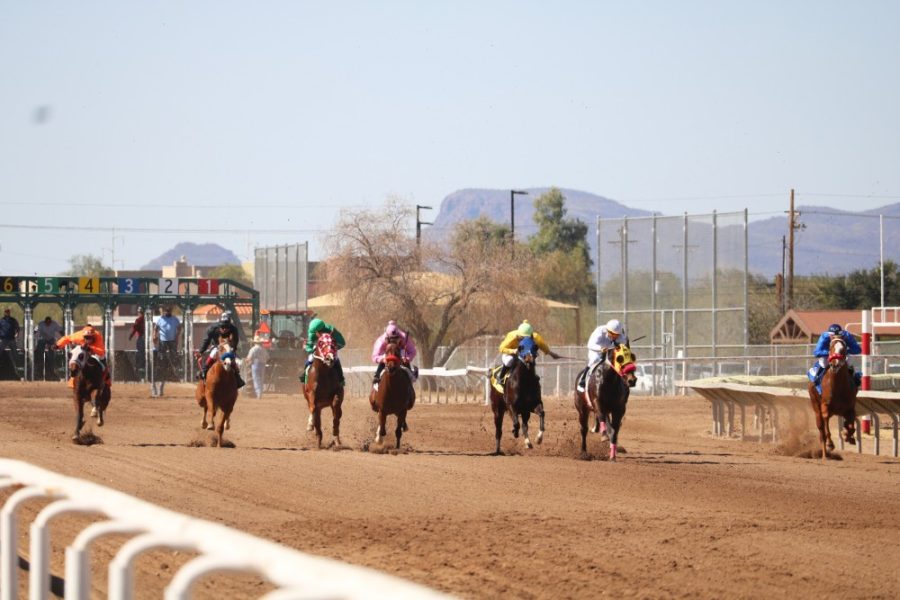On Saturday afternoon at Belmont Racetrack outside New York City, University of Arizona graduate Bob Baffert’s horse, Justify, took home the most prestigious championship in horse racing: The Triple Crown.
A three-year-old colt, Justify is Baffert’s second horse in four years to earn the Crown, but he wasn’t the only horse competing Saturday with a UA connection. Here are the four big UA winners from this Triple Crown season.
RELATED: At Rillito Racetrack’s opening weekend, UA students aren’t horsing around
1. Bob Baffert and Justify
The Nogales-born Baffert graduated from UA’s Race Track Industry Program, part of the university’s School of Animal and Comparative Biomedical Sciences in the College of Agriculture and Life Sciences.
Active in his youth as a quarter horse trainer, he got his start at Rillito Downs Race Track just up First Avenue, on River Road.
“It’s been monumental in starting my career,” Baffert told local CBS affiliate KOLD in 2011. “It was a stepping stone for me.”
Baffert made the jump to thoroughbred racing seamlessly after graduation from RTIP, training eventual two-race Triple Crown winners Point Given and War Emblem.
Baffert would eventually break through where other trainers failed, snapping a 37-year drought between Triple Crown Winners with American Pharoah. His second Triple Crown puts him in rarefied air as only the second trainer ever to accomplish the feat.
A prolific trainer of high-level thoroughbreds, Baffert also had another horse in the race: Restoring Hope, who finished eighth. However, it was Justify that stole the show.
He is only the second undefeated Triple Crown champion, with a record of 4-0, including the three big-money races.
The win also made the colt the most valuable horse in racing history, his value eclipsing $75 million, according to ESPN.
And Baffert and Justify’s ownership team have no intentions of retiring the colt yet.
“He’s now become a household name,” said Elliott Walden, the CEO and racing manager for WinStar Farm —Justify’s majority owners — to USA Today. “I’m looking forward to his next race just as much as you guys are.”
2. Gronkowski (the horse)
The second-place finisher, Gronkowski, was named for the UA and New England Patriot tight end Rob Gronkowski. Although under the primary ownership of Phoenix Thoroughbred, Ltd., the famous footballer bought a minority stake in the colt in April of this year.
Upon buying the horse, Gronkowski told the Washington Post that he’d “never dealt with horses.”
He also looked forward to perhaps taking the horse through its paces.
“Hopefully I can get a ride on the horse,” Gronkowski said. “I’m not trying to ride it for a full speed ride. I just want to get the feel of what it’s like to be on top of one. Maybe I’ll go for a full speed ride once I get comfortable.”
In true Gronkowski (the man) style, the three-time Super Bowl Champion bet $69 on his eponymously named horse, collecting close to $950 on the colt’s second place finish.
3. Todd Pletcher
While Baffert may get the big headlines, another RTIP graduate, Todd Pletcher, also trains thoroughbreds at the very highest level. Before the race, he assessed his and other trainer’s chances at stopping Justify with Forbes Magazine.
“I think,” Pletcher said, “like all of us, that we need for Justify to wake up on the wrong side of the bed to have a chance.”
After graduating from the UA in 1989, the Dallas, Texas native went on to train under the tutelage of legendary — and still active — trainer D. Wayne Lucas in New York, and soon became Lucas’ assistant.
After breaking off on his own in 2004, Pletcher would go on to train multiple Triple Crown-race winners, including filly (the term for a female thoroughbred) Rags to Riches — the first filly to win the Belmont Stakes in over a century.
For the Belmont, Pletcher had two horses start: Vino Rosso and Noble Indy. Vino Rosso finished fourth, with Noble Indy rounding out the field in tenth place.
RELATED: Rillito Race Track admission free for UA students and faculty during ‘U of A Days’
4. UAs Race Track Industry Program
Arizona may not be the first state that blue-blood, East Coast horse aficionados think of when they think of thoroughbred racing. But that’s not something that deters the director of UAs Race Track Industry Program(RTIP), Wendy Davis.
She said the program is riding high after another Triple Crown season dominated by UA-educated trainers and are especially proud of Baffert.
“It was absolutely fantastic,” she said. “Not only is he a graduate of the program, but also … being from Nogales, being a local person who also went to school here makes it even more special.”
Since Baffert’s first Triple Crown in 2014, RTIP has enjoyed a higher profile both locally and nationally according to Davis. However, because of the programs limited size, it has not really translated to a spike in applications.
“We have a pretty consistent level of interest,” Davis said before pointing out that while interest in the sport may peak during the late spring, most applicants are out doing the every-day work of the track year-round.
“Although the rest of the world only watches basically the [Kentucky] Derby and then the Triple Crown if there is a chance for a Triple Crown winner,” she said. “The reality is there are major races every month of the year all throughout the year.”
Davis said that with RTIPs unique approach of having students interested in training horses learn the business side of the trade, and vice-verse, the program has set itself up for long term success.
“The most important thing is understanding how the entire business works,” she said. “Everyone who graduates has the same base of knowledge to draw from.”









